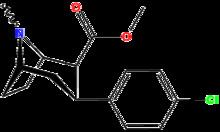CAS Number 130342-80-2 ChemSpider 559091 3D model (Jmol) Interactive image | PubChem CID 644015 Formula C16H20ClNO2 Molar mass 293.788 g/mol | |
 | ||
(–)-2β-Carbomethoxy-3β-(4'-chlorophenyl)tropane (RTI-4229-31) is a synthetic analog of cocaine that acts as a stimulant. Semi-synthesis of this compound is dependent upon the availability of cocaine starting material. According to the article, RTI-31 is 64 x the strength of cocaine in terms of its potency to elicit self-administration in monkeys. WIN 35428 was 6 x weaker than RTI-31, whereas RTI-51 was 2.6 x weaker than RTI-31.
Contents
A further advantage, in addition to potency of this compound, is that its duration of activity is longer than for cocaine. It could therefore be considered within the context as an agonist based therapy for treating cocaine addiction, although it is actually RTI-336 that entered into clinical trials with this in mind. RTI-31 is already completely psychoactive in its own right meaning that further chemical manipulation should be viewed as an option that is not strictly necessary. RTI-336 is actually made using RTI-31 as starting material. RTI-31 is not an entirely selective DRI in that it also has appreciable SERT and NET blocking affinity. RTI-31 can easily be "cleaned" though, as is done, for instance, by replacing the carbomethoxy ester with a more sterically occluded substituent such as is done for RTI-113.
Binding and Uptake Selectivity
Based on the uptake of tritiated biogenic monoamine radiotracers it can be confirmed by observing the figures in the attached table that RTI-31 is a relatively balanced reuptake inhibitor wrt the D/N/S ratio.
The binding ligand affinities for the different transporters is skewed somewhat in favor of the DAT; there may be some bias in the data. The reason for this could be that WIN35428 is relatively easier to displace from the DAT versus paroxetine from the SERT, because of the higher binding constant of the former compound.
Also it needs to be borne in mind the idea of transporter promiscuity. It may be possible that the NE levels are raised, at least in part, through DAT blockade.
RTI-31 lies somewhere in the middle of the table between troparil on one end and RTI-55 on the other. It is not as selective as RTI-113 for the DAT, but is more selective than Dichloropane is for this transporter. RTI-31 also has some muscarinic acetylcholine agonist activity.
Data in Above table from rats brains (1995). More recent work has advocated using cloned human transporters.
RTI
Conversion of ester in RTI-31 to heteroaromatic nuclei also possible. E.g. RTI-470 was among the potent DRI known to exist, 0.094nM.
Kozikowski
Further chemical modification of RTI-31 leads to novel chemical entities; some of them are highly potent, and one of them has been reported as lasting for three days (z-chloro-vinyl analogue).
(i)1 N HCl, reflux 15 h; (ii) (a) POCl3, reflux; (b) MeOH, 0 °C; (iii) 4-ClPhMgBr, Et2O, –40 °C; (b) –78 °C, 1.1 equiv TFA; (c) silica gel chromatography; (iv) DIBAL, toluene, –78 °C; (v) ClCOCOCl, DCM, –78 °C, DMSO, 30 min, TEA; (vi) Ph3P+CH2RBr−, n-BuLi, THF, room temp; (vii) H2, Pt/C. 40 psi, cyclohexane.
This is because of the compounds increased lipophilicity. The act of changing a drug's duration of action through altering its lipophilicity is commonly observed and not limited to this one.
If read nocaine, interesting n-propyl group chosen,
